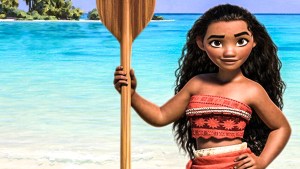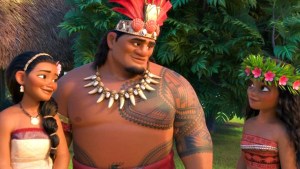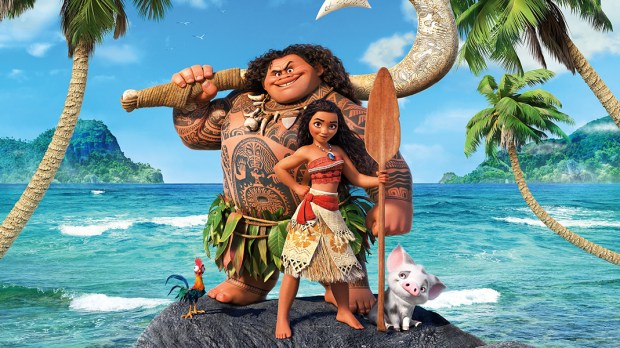Every time I’ve watched Moana with my young children over the past four years, I’ve wondered whether one of the screenwriters or songwriters was Catholic. The film gives children a wonderful way to understand what a “vocation” is, and has so many other profound lessons related to faith. I’ve used several scenes from Moana to help explain religious concepts to my children, much as St. Patrick used a shamrock to illustrate the Trinity: It’s not a perfect depiction, but the symbolism is strong enough to make it a useful teaching tool.
These observations are the fruit of watching Moana over and over with my kids over the years. These are the top 5 ways I use this movie to talk about faith with my young children, and use it to make abstract concepts like “vocation,” “tradition,” and “the communion of saints” easier for them to understand. (Warning: This article does contain spoilers.)
1You were called and chosen for a special purpose.
Baby Moana’s “baptism” by the ocean was my first clue to this film’s profound Christian implications. She’s walking on the beach one day when the ocean offers her pretty pink shells, then lovingly splashes her and gives her the key to her special mission: the glowing, green stone that is the heart of Te Fiti, the “mother island.”
The shells, the splashing water, and the mission are all rich in baptismal symbolism. You can explain to a child, “Just as Moana received a special mission when the ocean splashed her with water as a baby, you received a special mission too, on the day you were baptized.” That vocation is twofold: First, all Christians have the same calling, to “know, love and serve God” and other people, as Christ told us in the “Greatest Commandment”:
“Teacher, which is the great commandment in the Law?” And He said to him, “‘You shall love the Lord your God with all your heart, and with all your soul, and with all your mind.’ This is the great and foremost commandment. The second is like it, ‘You shall love your neighbor as yourself.’ On these two commandments depend the whole Law and the Prophets.” (Mt 22:36-40)
Second, each person has an individual vocation, which will become clear to them through prayer and circumstances in life. Later in the movie, Moana says of her vocation, “And the call isn’t out there at all; it’s inside me.” What an amazing way to remind children that God speaks directly in our hearts! It’s tempting to wish God would just “call us on the phone” and make His will for us crystal clear, but we can hear His voice with surety if we make space for silence and listen attentively to His “still, small voice” in our souls.
When Moana makes this last remark, she has lost faith in her mission and is about to turn back, when the spirit of her dead grandma comes to encourage her and remind her of who she is. Her grandma was a witness to her “baptism” by the ocean all those years before. In the same way, we can tell our children, we have godparents and other family and friends as witnesses at baptisms, to remind us of our mission and steer us back on course if we ever need it.

Read more:
5 Timeless truths about the heart you’ll find in ‘Moana’
2Ancient traditions have wisdom beyond our understanding.
One thing I especially love about this movie is that the traditions of long-ago ancestors are celebrated and honored. These traditions save the lives of Moana and her people as they learn to be voyagers once again, a skill their people had forgotten for centuries. So many children’s movies are about breaking from tradition and “being your own person” in a way that totally rejects history, family, and community. Moana’s admiration for and imitation of her ancestors is a refreshing change. If nothing else, her story makes clear the importance of remembering and learning from history.
As Catholics who believe in the vital role of Sacred Tradition, the emphasis on tradition in this movie is especially heartwarming. In a flashback to Moana’s ancestors, they sing, “We tell the stories of our elders in a never-ending chain.” This line has so much meaning to those who follow the rhythms of the liturgical year. You might point out to your children that we, too, tell the stories of our elders in a never-ending chain: the chain of Scripture, read in the Liturgy and Divine Office every day of the year, and the stories of the saints that we recall each year on their feast days. It even calls to mind the “never-ending chain” of papal Apostolic Succession. In these stories that we tell over and over again, we, like Moana’s people, find identity and meaning.
3God is guiding you to the right place, even when everything seems to be going wrong.
How many times in our lives has it seemed like everything is falling apart, and we wonder where God is in this disaster—only to have things work out at last, in a way that could only be divinely orchestrated? When Moana, a novice sailor, is on her way to Maui’s island, a terrible storm overtakes her little boat and she nearly drowns in the raging waves before being cast on unknown shores. She is afraid and frustrated, yelling out angry insults at the ocean, which she thinks has ruined her journey … until a few minutes later, when she realizes the ocean has delivered her to her intended destination, and much more quickly than she could have done on her own.
The ocean seems like a stand-in for the Holy Spirit in this movie, from the “baptism” scene to the many ways it helps Moana along her journey. I don’t want to belabor this analogy, as of course the ocean is no real comparison to God, but the film looks very different when you watch it with the understanding that the ocean is doing for Moana what God might do in a person’s life. It not only steps in to help her when she can’t do it on her own, but it turns seeming disasters into triumphs.
You might explain to a child, “You remember how Moana was mad at the ocean for messing up her journey, but it actually helped her get to Maui’s island? Sometimes God works like that in our lives. We think something bad is going to happen, but it ends up being the best thing that could happen, and helps us in ways we never expected.”
4The people we love who have died are still with us.
Towards the end of the movie, Moana has lost hope in her calling and is thinking about turning back, when the spirit of her dead grandmother comes to talk to her and encourage her. This “ghostly” presence may seem a bit odd at first glance, but as Catholics, we are very comfortable talking to people after they have died. Just think of how often we talk to the saints in Heaven!
This scene is a great way to explain the Communion of Saints. Just because someone has died doesn’t mean they aren’t still part of our lives and families; it doesn’t mean they can’t see and hear us, and care what we’re doing. This scene beautifully illustrates for even very young children how thin is the veil that separates this world and the next.
During her visit, Moana’s grandmother says, “Nothing on earth can silence the quiet voice still inside you.“ This line points back, again, to the importance of listening carefully to God’s voice in our souls. The scene calls to mind how the saints’ examples inspire us along the road to heaven.
5Knowing your true identity brings peace and happiness.
At the end of the movie, in her great confrontation with the villainous lava monster, Moana realizes that it’s not a monster at all but Te Fiti, the “mother island,” whose heart was stolen. Moana responds to the monster with compassion, and restores the lava monster to her former self who is beneficent and gentle. She says, “This is not who you are. You know who you are.”
The villain is saved when Moana recalls her to her true self; in the same way, conversion of heart comes when a person is recalled to his or her true identity as a beloved child of God, with immeasurable dignity and worth, called to love and serve God and neighbor. As St. Catherine of Siena said, “Be who God meant you to be and you will set the world on fire.” So Te Fiti is free to be good when she is able to be who she is meant to be.
Only Te Fiti is not setting the world on fire, but filling it with glorious new life. Once the lava monster is restored to her true identity, the island sprouts forth in bright flowers and lush green trees, covering what was a barren rock. This scene is visually stunning and provides a powerful image to demonstrate the effect of grace on the soul: A soul in a state of grace, attuned to God’s will, bears the “fruits of the Spirit” and the good works of which Christ said, “By their fruits you will know them” (Mt 7:20).
Identity is a dominant theme of this movie: Characters repeatedly make reference to “who you are,” asking “Do you know who you are?” The movie’s answer is that “who you are” is a person rooted in a family, a place, and a tradition, while answering an individual call heard within the heart. This is made clear in the “I am Moana!” anthem Moana sings toward the end of the film:
I am a girl who loves my island I’m the girl who loves the sea It calls me I am the daughter of the village chief We are descended from voyagers Who found their way across the world They call me I’ve delivered us to where we are I have journeyed farther I am everything I’ve learned and more Still it calls me And the call isn’t out there at all, it’s inside me It’s like the tide, always falling and rising I will carry you here in my heart you’ll remind me That come what may I know the way
Moana defines herself as a direct continuation of her ancestors and their mission. She also defines herself as inextricably connected to her home and family, and she follows her personal vocation not to break away from them, but to bring them back to the greatness of their tradition. Moana triumphs in her calling because of her filial love for her family and people, not in spite of it: She “carries them in her heart,” where they show her the way.
Of course, not all “traditions” are worth returning to, and that goes without saying. But if we understand Moana’s return to ancient ways in light of the Sacred Tradition that Catholics hold to be a crucial source of truth, the implications are profound. It’s something to reflect on, and discuss with our children. Why is it so important for Moana to learn the way that the ancestors lived? Why is it so important for us to practice ancient Church traditions like the liturgies, the sacraments, and the liturgical year? There’s so much to unpack here, but at the least, Moana shows our children that learning from the past can help us greatly with present-day problems.
There is so much more that could be said (the significance of the ships, for example, viewed in light of the Church being called “the Ark of Salvation”), but these are the primary reasons that this film is such a gem. Parents can use Moana as a springboard to start conversations about vocation, community, tradition, saintly guidance, history, identity, and so many other important topics. It’s my favorite of all the “princess” movies by a long shot, and I hope these considerations might make it your favorite, too.

Read more:
The 2 parenting lessons I’ve learned from ‘Moana’ as a father

